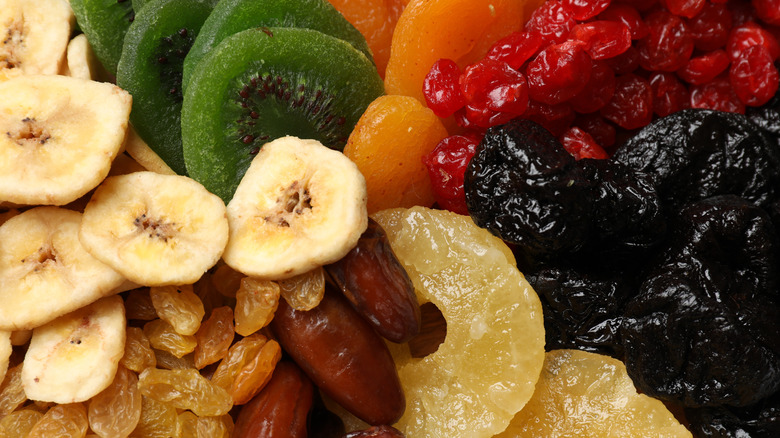This Is Why Dried Fruit Is So Much More Expensive Than Fresh
We may receive a commission on purchases made from links.
Dried fruit is the perfect on-the-go snack. It's compact, fun to eat, and lasts a long time before going bad. For my household, a Costco trip isn't complete without a pack of dried mangoes. At around $20 a bag, this snack is one of the most expensive items in my Costco cart. Whether you like your dried fruit sugar-coated or spicy, chocolate-dipped or yogurt-covered, it feels like a luxury item. Why the hefty price tag?
Producing dried fruit requires a lot of time and labor, and it comes with expensive overhead costs. Commercial dehydrators cost tens of thousands of dollars (or more) and are expensive to operate. Drying fruit takes several hours at a minimum, and fruits like dates and plums need up to about 20 hours. Those long drying times mean higher energy bills.
Fruit is carefully selected and sorted before drying to ensure the best-tasting final product. When it's done, dried fruit often travels long distances to get to your local grocery store, and the cost of shipping adds to the shelf price. Many dried fruits are imported to the United States from places like Mexico, China, Turkey, and Thailand. If you think about it, the cost is justified. When you buy dried fruit, you're getting a lot of bang for your buck. Fruit shrinks dramatically when dried, so a bag of your favorite dried fruit contains dozens of individual pieces of produce.
How to save money on dried fruit
To get dried fruit without blowing your budget, you have a few options. If you want to try your hand at making your own dried fruits at home, you can buy a food dehydrator for around $50, like this one from Elite Gourmet. Larger appliances will typically cost you upwards of $150 or so.
However, the investment may quickly pay for itself if you eat a lot of dried fruit. It's also a great way to minimize food waste. You can save money by purchasing fruit that is on sale because it has cosmetic flaws or is close to going bad. Online services like Imperfect Foods or Misfits Market are good resources to check out for fruits that are perfectly edible but may not be quite as pretty. Local produce sellers or farmers markets may also have good deals on in-season fruits.
To find dried fruit at a reasonable price, check out Costco, Trader Joe's, and even stores that don't focus on groceries. I've found every flavor of dried mango you could imagine on my T.J. Maxx and HomeGoods adventures. You can also buy sweetened dried fruit, which tends to be cheaper than the unsweetened products because sugar acts as a preservative. The addition of sugar allows for shorter drying times and also adds weight, meaning companies can place less fruit in each package.

